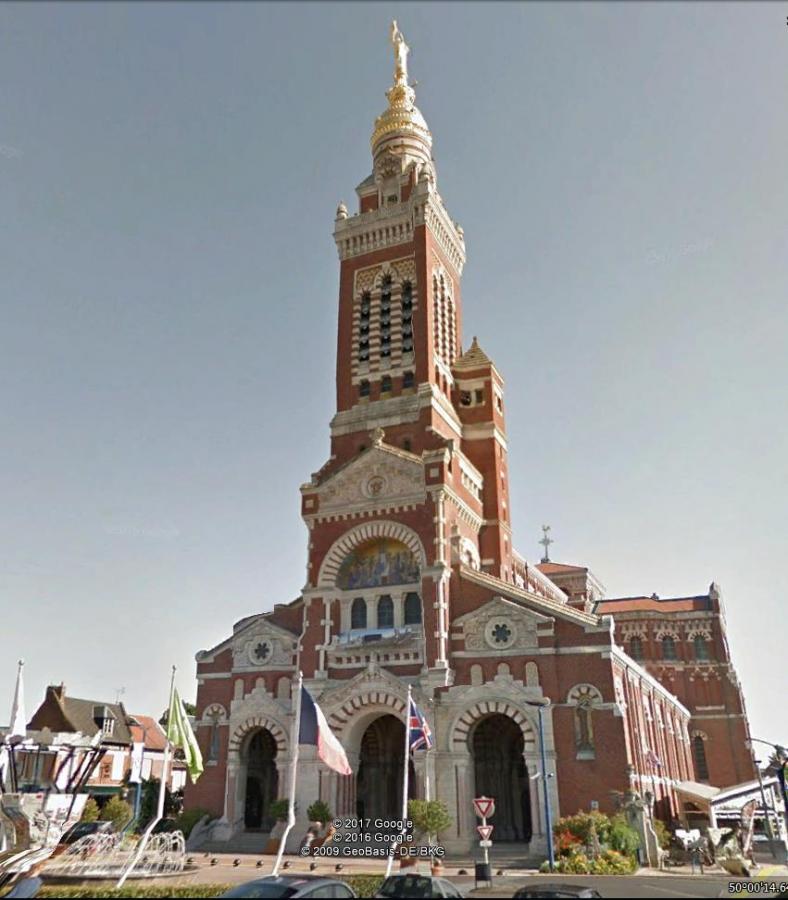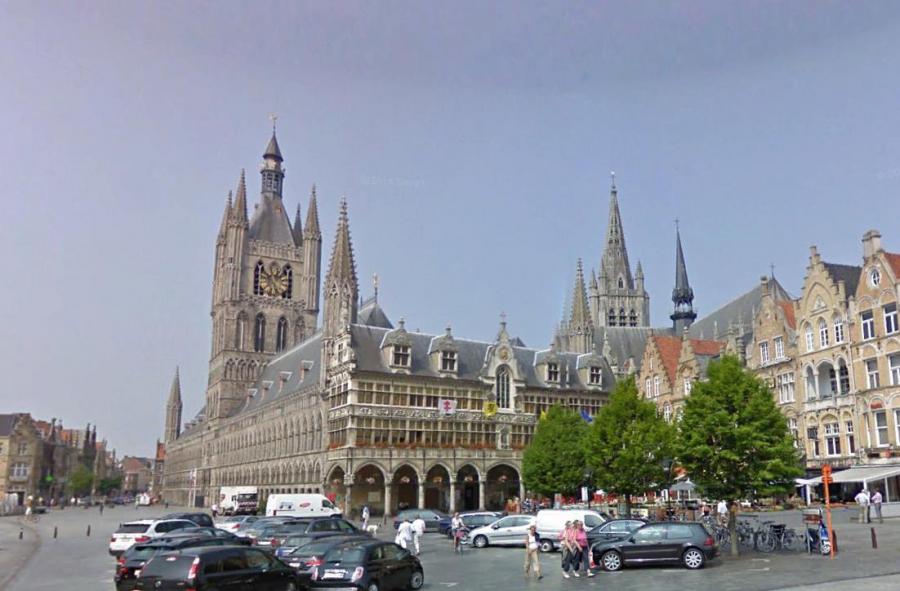Art of Nation: Insightful 'then and now' comparisons
The Memorial’s online, interactive exhibition Art of Nation will enable users to compare field sketches by Australia’s First World War official war artists with contemporary digital imagery of the same locations in Google street view. Comparing ‘then and now’ images encourages a ‘spot the difference’ method of analysis, reminiscent of puzzle books in which images are replicated with minor changes to be discovered. These comparisons invite us to delve beyond surface level visual analysis and consider the history of these places. In this post I will explore some of the stories that feature in Art of Nation.

George Benson’s depiction of the damaged Basilica of Notre Dame de Brebières (A ten-minute sketch of Albert Church c. July 1916) shows the statue of the Virgin Mary with the infant Jesus atop the spire hanging parallel to the ground. Today, the rebuilt basilica has a copy of the statue in an upright position. Visual comparison between Benson’s sketch and Google street view suggests a statue that had once toppled has simply been reinstalled. Examining this comparison in further detail raises questions, such as what caused the statue to topple? Why did Benson sketch this church?
During the German bombardment of Albert in 1915 the church tower was hit and the Madonna toppled and hung precariously. The leaning statue became infamous. It was seen by hundreds of thousands of soldiers who marched through the town and it was reproduced in photographic postcards that were sent all over the world, often by soldiers contacting their loved ones back home. Benson was one of a number of artists and photographers who sought to capture this well-known sight. The leaning statue so resembled a diver in flight that Australians christened her Fanny Durack, after the famous Australian swimmer who won the 100 metres gold medal at the 1912 Stockholm Olympic Games.
A legend arose that whoever knocked the statue down would lose the war. It was knocked down in April 1918 by British artillery to prevent German forces from using the basilica as an observation post after the Germans had captured the town during their Spring Offensives. The statue itself was never recovered and it is thought to have been shipped to Germany for its metal value.
The leaning statue was a spectacle. In its toppled state it represented the chaos and destructiveness of war. Returned to its upright position, the replica statue implies order has been reestablished. The position of the statue is charged with emotion, not just because it is a religious sculpture of the Virgin Mary and Jesus, but also because of the symbolism and infamy it attained during the war.
Another field sketch that offers an interesting backstory when compared to online Google street view images is Benson’s sketch The Cloth Hall at Ypres (July 1916). The artist depicted the shell-damaged ruins of the medieval Cloth Hall and St Martin’s Cathedral in the Belgian town of Ypres, now known as Ieper (its Flemish name). The ruins of the historic Cloth Hall were also depicted by other Australian official war artists, including Fred Leist (ART02884) and A Henry Fullwood (ART02452). By mapping field sketches, Art of Nation reveals how certain locations attracted several different artists, suggesting that these particular sites were noteworthy at the time; the reasons for which are not always immediately obvious to contemporary audiences.
Ypres was the scene of almost constant fighting throughout the First World War as it was a strategically important town. The British defences at Ypres formed a major salient, a bulge, in the allied front line. German forces continued to shell the town, razing the architectural treasures of much of medieval Ypres, including the Cloth Hall and St Martin’s Cathedral, to the ground.

Comparing Benson’s wartime scene of Ypres in ruins with the building today, is an engaging means of exploring the story behind Ypres’s medieval splendour and its fascinating recreation.
The Cloth Hall was comprised of a series of buildings surrounding a rectangular courtyard. Construction commenced in 1200 and it was not finished until 1304. During medieval times the Cloth Hall was the commercial heart of the city, and, as its name suggests, it was where the town’s trading in cloth and wool took place. Also integral to the town’s history was St Martin’s Cathedral; construction begun in 1254 and it was completed over the following two centuries. The destruction of St Martin’s Cathedral during the First World War was widely reported in Australian newspapers with considerable anger directed at the Germans. For example, Melbourne’s Advocate on 30 January 1915 described German forces as “modern vandals” who continued “to pour shot and incendiary shells into the smoking ruins.” (‘The Bombardment of Ypres’, p. 13). Once grand feats of architecture at the heart of Ypres, the Cloth Hall and St Martin’s Cathedral, were reduced to ruins during the war, as seen in Benson’s watercolour.
After the war ended on 11 November 1918, debates soon erupted about the best form of post-war reconstruction. The returning residents of Ypres were faced with rebuilding their entire town. In 1919, Winston Churchill, Great Britain’s future prime minister, contended that Ypres should be permanently preserved in its ruined state as a monument to the hundreds of thousands of British and Empire soldiers who fought there during the war. The Ypres townspeople lobbied to reclaim and reconstruct their town. The prevailing opinion favoured rebuilding Ypres exactly as it had been. This architectural conservation project was guided by the comprehensive archive of plans and photographs that Jules Coomans, the municipal architect, had systematically accumulated since his appointment in 1895. The rebuilding was paid for by Germany, as one of the penalties imposed upon it by the Treaty of Versailles, which officially ended the war in 1919.
It took more than forty years to rebuild the razed city of Ypres. Rebuilding the Cloth Hall begun in 1928 and its reconstruction was finished in 1967. Housed in the rebuilt Cloth Hall is the In Flanders Fields Museum (previously the Ypres Salient Memorial Museum), which presents the story of the First World War in the West Flanders region. The rebuilding of St. Martin’s Cathedral was finished in 1930. Interestingly, the Cathedral was rebuilt with a pointed spire. Before the war, the spire had been a square tower. This change was viewed as an ‘enhanced’ form of restoration to replicate a spire that had collapsed as long ago as 1433.
A key feature of Art of Nation is the comparison of First World War field sketches and the same sites via Google street view. George Benson’s A ten-minute sketch of Albert Church (c July 1916) and The Cloth Hall at Ypres (July 1916) are just two examples that demonstrate the historical insight that can be gained by considering these comparisons. I found this process of ‘spot the difference’ to be addictive; my fascination with the ‘then and now’ imagery led me into a deeper understanding of the historical events.